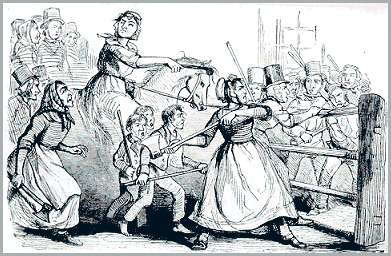Your basket is currently empty!

19th Century Wales & the Rebecca Riots
In the 19th century, between the years 1839 and 1843, rural Cymru saw a series of protests known as Terfysgoedd Beca (the “Rebecca Riots”). These protests were characterised by peasants disguising themselves as women and taking to the streets to voice their grievances.
Origins of the Rebecca Riots
The riots were a response to several issues, including the high tolls imposed on the use of roads and the challenging living conditions faced by many. The name “Rebecca” was often invoked as a symbol of protest, referencing the biblical figure who appeared in Genesis.
The desire for protest was caused by various factors. Firstly, poverty had grown out of control in the agricultural heartlands of Cymru – fueling a hunger for action. Secondly, famine had arisen in the area, a side effect of a particularly lengthy (and terrible) spell of rain which had devastated the area and brought about a drastic fall in food and crop prices, which devastated agricultural Cymru further.
Then, perhaps most significantly, the cost of entering through turnpikes – toll gates/roads – had increased. So, in short, the income of the farmers had fallen; rent had risen and so too had the cost of day-to-day living. This then led to the beginning of the protests, which typically took place at the turnpikes.
The Biblical Inspiration
The Rebecca Riots have become somewhat romanticised for the unusual, though effective, attire donned by the rioters. They would become “Merched Beca”, translated as “Rebecca’s Daughters”, and would wear 19th century Welsh feminine attire (consisting of a white gown, blackened or made up faces and/or a mask) with the leader of the riot donning the name “Rebecca” or “Beca”.
The origins of Rebecca can be traced back to the Bible, with a passage from Genesis 24:60, which says:
‘And they blessed Rebekah and said unto her, Thou art our sister, be thou the mother of thousands of millions, and let thy seed possess the gate of those which hate them’.
Genesis 24:60
Clever Choreography & the Cooldown
The turnpikes would also bear witness to a choreographed, communicative chant between Rebecca and her daughters, which would go as follows:
Rebecca: “What is this my children? There is
something in my way. I cannot go on….”
Rioters: “What is it, mother Rebecca? Nothing should
stand in your way,”
Rebecca: “I do not know my children. I am old and
cannot see well.”
Rioters: “Shall we come and move it out of your way
mother Rebecca?”
Rebecca: “Wait! It feels like a big gate put across the
road to stop your old mother.”
Rioters: “We will break it down, mother. Nothing
stands in your way.”
Over time, the Riots shifted attention to the landlord class, who had risen the cost of rent for farmers during a time when they most needed leniency and extra support. However, by this time – towards the end of the Rebecca Riots in 1843 – the rioters were far less “rioters” and far more “protesters”. By the fall of 1843, the situation in west-Cymru had improved somewhat, meaning that the demand for action was slightly less desperate. There had, however, been the murder of a woman, Sarah Williams, on September 7th 1843 and this potentially ushered in a period of reflection and a raised awareness to the possibility that the riots were losing direction.
More from Welsh Histories
Welsh Histories is a Welsh history celebrating platform which looks to promote all aspects of Welsh history. Though we focus predominantly on native Welsh history, we do also share the non-native aspects from time to time. You can follow us on Facebook; Instagram or Twitter for more. You can also support us as a member of our Patreon community. A reader? We also have our very own Welsh Histories Shop where we sell our Welsh Histories Magazine. Diolch yn fawr iawn and keep enjoying Welsh Histories.
Niklas is the founder, owner, manager, editor, writer, video creator, voice over artist, and so forth, of Welsh Histories. He is passionate about the preservation of Welsh culture; the rejuvenation of the Welsh language and the promotion of Welsh history. Niklas currently resides in Pune, Maharashtra, with his beloved wife.

